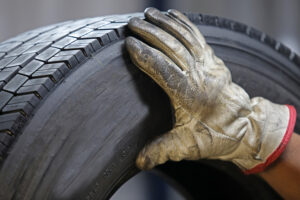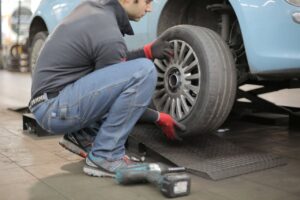Tyre Maintenance Checklist: Regular Inspections for Optimal Performance
When it comes to road safety, one of the most overlooked aspects is tyre maintenance. Properly maintained tyres are essential for a smooth and safe driving experience. Not only does regular maintenance ensure your safety on the road, but it also extends the lifespan of your tyres, saving you money in the long run. Check out our comprehensive tyre maintenance checklist to help you keep your tyres in optimal condition.
Regular Pressure Checks
Ensuring your tyres maintain the correct pressure levels is paramount for both your safety and your vehicle’s fuel efficiency. Adequate tyre pressure guarantees optimal traction, stability, and handling. All crucial factors in emergency situations.
Properly inflated tyres distribute the vehicle’s weight evenly, preventing uneven wear and minimising the risk of dangerous blowouts. By regularly undertaking pressure checks, especially before long journeys, you can significantly enhance road safety by reducing these risks.
It’s also important to keep in mind that under-inflated tyres increase rolling resistance, forcing your engine to work harder. This leads to higher fuel consumption. So, by keeping your tyres correctly inflated, you not only save on fuel costs but also contribute to a greener environment by reducing emissions.
To undertake a tyre pressure check, start by ensuring your vehicle is parked on a level surface and the tyres are cold. Refer to your vehicle’s owners manual or the label located on the driver’s side door jamb or inside the fuel filler cap for the recommended tyre pressure values.
Remove the valve cap from each tyre and use a reliable pressure gauge to measure the pressure. Compare the readings with the recommended values, if they’re too low, add air until the correct pressure is reached. Don’t forget to check the spare tyre too if you have one. Finally, replace the valve caps and ensure they are secure.
Tread Depth Inspection
Having sufficient tread depth is fundamental for ensuring your vehicle’s traction and handling capabilities, especially on wet or slippery roads. While the legal minimum tread depth is 1.6mm, it’s advisable to consider replacing your tyres when the tread depth reaches 3mm. Adequate tread depth allows the tyre to disperse water effectively, reducing the risk of hydroplaning and improving grip. To assess your tyre’s tread depth accurately, use a tread depth gauge or rely on the Tread Wear Indicator (TWI) bars moulded into the tyre’s grooves.
Place the gauge or the edge of a coin like a 20p coin into the grooves of your tyres with the Queen’s head facing down. If the tread doesn’t cover the Queen’s head or the gauge indicates a depth below 1.6mm, it’s time to replace your tyres.
Make sure to measure the tread at multiple points across the width of the tyre and in different grooves as tyres can wear unevenly.
Regular Rotation
Uneven tyre wear can be a common issue due to varying road conditions and driving habits. You can extend your tyre lifespan with a straightforward solution: regular tyre rotation. By rotating your tyres at regular intervals, you ensure even wear across all tyres. This practice is especially vital because front tyres wear out faster than rear ones due to steering forces. Rotating them helps maintain a balanced wear pattern, enhancing the longevity of your tyres. It’s a simple yet effective way to save money and ensure a smoother, safer driving experience.
To rotate your tyres, make sure your vehicle is parked on a flat and level surface with the parking brake engaged. Consult your vehicle’s owner’s manual for the recommended rotation pattern as it can vary depending on whether your car is front-wheel drive, rear-wheel drive or all-wheel drive.
Typically, you’ll need to remove each tyre and remount it in a different position on the vehicle. For instance, you may move the front tyres to the rear and vice versa. Or you might crisscross the tyre diagonally. Be sure to tighten the lug nuts in the crisscross pattern to the manufacturer’s torque specifications.
Regular tyre rotation should be performed every 6000 to 8000 miles and helps to promote even wear, improves traction and ultimately saves you money and ensures safe driving.
Wheel Alignment and Balancing
Misaligned wheels can lead to uneven tyre wear, impacting both your tyres and your vehicle’s handling. If you ever feel your steering wheel vibrating or notice your vehicle pulling to one side, it’s a clear sign that your wheel alignment and balance need attention. Ensuring your wheels are properly aligned not only extends the life of your tyres by preventing uneven wear but also has a positive impact on your fuel efficiency. Properly aligned wheels reduce unnecessary friction, allowing your vehicle to move more efficiently, saving you money on fuel costs.
To perform wheel balancing it’s important to locate a reputable garage or mechanic that offers this service through the use of a wheel balancing machine. They will remove the wheels and tyres from your car and mount them onto the machine.
The machine will then spin the wheel and measure any imbalances in the weight distribution. To correct these imbalances the mechanic will attach small weights to the rim of the wheel in the areas where needed. Ensuring that the wheel is properly balanced. After this adjustment, the mechanic will recheck the balance and ensure it’s within the specified tolerances.
Wheel balancing is typically recommended when you notice a vibration or uneven tyre wear. It’s also recommended when you install new tyres. It’s a relatively quick service that’s best left to professionals who have the necessary equipment and expertise to perform it accurately.
Inspect for Damage
Regular inspections are your first line of defence against unexpected tyre issues. Take a few moments to visually check your tyres for cuts, bulges, or any visible damage. Even seemingly minor cuts can escalate into dangerous blowouts if ignored.
To do this, begin by visually examining each tyre. Look for signs of cuts, bulges, punctures or any irregular wear patterns. Such as excessive wear on one side of the tyre. Pay attention to the tread, checking for embedded objects like nails or glass shards. Run your hand over the tyre’s surface to feel for any unusual bumps or irregularities. Inspect the side wall for cracks, splits or damage.
Swift action is key – if you spot any damage, don’t delay. Reach out to a professional tyre service immediately.
Seasonal Changes
In regions with extreme weather, adapting your tyres to the seasons can significantly enhance your driving experience. As temperatures drop and snow blankets the roads, winter tyres step up to the challenge, offering superior traction on snow and ice. Come warmer months, it’s time to switch to summer tyres. Specifically designed for higher temperatures, they ensure optimal performance in diverse weather conditions. This simple yet effective seasonal swap ensures your tyres are equipped to handle the challenges each season brings, making your journeys safer and more comfortable.
Proper Storage
If you have spare tyres or need to store tyres for seasonal use, ensure they are stored in a cool, dry place away from direct sunlight. Consider investing in tyre covers to protect them from the elements.
Start by cleaning the tyres to remove dirt, grime, and brake dust. Ensure they are completely dry before storing them. Ideally, place them in a cool, dry, and well-ventilated area away from direct sunlight and sources of heat.
To prevent flat spots and weight distortion, stack the tyres horizontally or hang them on hooks. It’s crucial to keep them away from solvents, fuels, and chemicals as these can deteriorate the rubber.
Cover the tyres with protective tyre bags or wrap them in plastic to shield them from ozone and moisture. Every few months, inspect the stored tyres for any damage or signs of deflation. Following these steps will help maintain your tyres in excellent condition while they are not in use, ensuring they perform their best when you’re ready to reinstall them on your vehicle.
By staying on top of your tyre health, you can enjoy a multitude of advantages while avoiding potential disadvantages. Let’s delve deeper into the importance of regular tyre maintenance and weigh the pros and cons.
Advantages of Regular Tyre Maintenance
- Enhanced Safety
- Extended Tyre Lifespan
- Improved Fuel Efficiency
- Cost Savings
- Better Performance
Disadvantages of Neglecting Tyre Maintenance
- Reduced Safety
- Decreased Fuel Efficiency
- Uneven Wear and Tear
- Risk of Blowouts
Regular tyre maintenance is more than just a responsibility, it’s a crucial investment in your safety and vehicle longevity. By dedicating a little time to routine inspections, you’re not only ensuring your safety on the road but also saving money in the long run. At etyres, we prioritise your safety and vehicle performance.
Explore our range of high-quality tyres and services to keep your tyres in optimal condition. Your journey towards safe and efficient driving starts with well-maintained tyres. Drive responsibly and discover the difference of a well-maintained vehicle.




